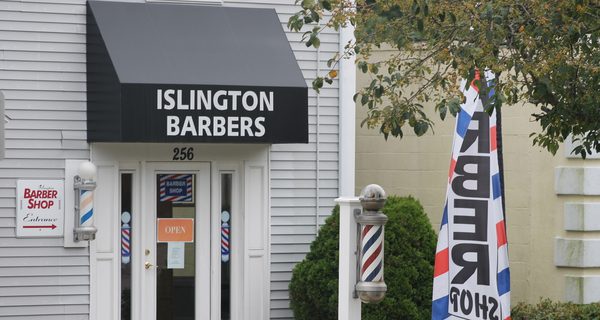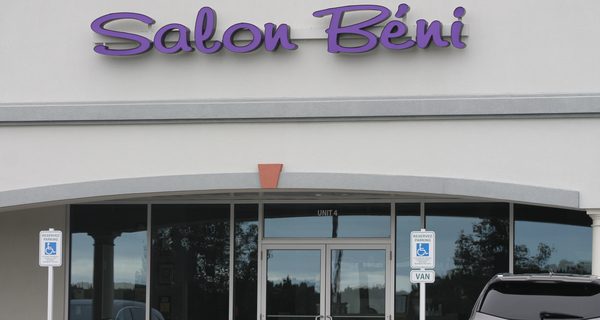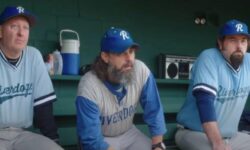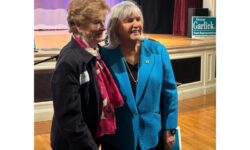Anthony’s Barbershop in Needham noted how many of their customers used the time they were closed to experiment with new hair styles.
By James Kinneen
Hometown Weekly Reporter
As COVID recedes, Hometown Weekly is taking a special look at how some of the businesses in its communities are transitioning back to post-pandemic circumstances.
From high profile COVID protocol scandals like Nancy Pelosi’s San Francisco salon trip and Lori Lightfoot’s home hair stylist visit, to entrepreneurs launching porch and lawn haircut services for those afraid to leave their homes, all the way to barbers giving free haircuts to those who get the vaccination shot, hair salons and barbershops have had far more memorable moments during the COVID-19 era than one would expect.
Yet, while the struggles of the restaurant industry have been thoroughly covered by the media, and there seemed to be a new beefy gym owner fighting against mask mandates and lockdowns every day on cable news, the struggles and adaptations of barbershops and salons were and are largely unknown.
To close this knowledge gap, we reached out to co-owner of Walpole’s Salon Beni Terri Nickerson, Matt Paturzo, aka “Matt the Barber”, of Islington Barber Shop in Westwood, and Sam Hawilla and Joe Harb from Anthony’s Barber Shop in Needham, to ask about how the industry is doing, how they’re adapting, and what getting a haircut might look like in the future.
The most common recurring theme was that the business became less friendly, in the name of safety. All three said that they got rid of magazines so people weren’t touching the same things. Paturzo eliminated lollipops, while Hawilla and Harb stopped letting kids reach into a bowl and pick their own, while Nickerson, who noted how much her salon prided itself on having a “homey” feel, got rid of the coffee patrons would usually drink.
“We kind of pride ourselves on the homeyness of the salon, and everything that really made our salon homey isn’t there anymore,” she explained. “We don’t offer coffee, we don’t offer water, there’s no magazines. People tend to still keep a distance from each other, so I guess the homeyness of everything that made our salon so special really had to turn kind of cold trying to keep everyone safe.”

But far more so than just getting rid of magazines or lollipops, the most telling sign the businesses were prioritizing safety over comfort (and to some degree profit) was in the appointment-only transition many made. Although they acknowledged using half-hour appointments would put a ceiling on the amount of money they could make in a day, Anthony’s Barber Shop moved to an online appointment system and eliminated walk-ins. As a result, the atmosphere isn’t quite what it used to be, as exemplified by their answer when asked what they most miss about their business before COVID-19 hit.
“We just miss having people in here, not worried, no masks, hanging out watching our TV and talking about sports the way they used to - feel comfortable where even after their haircut they’d still hang out for ten to fifteen minutes talking about whatever. But now it’s like they get their haircut and they book it straight out.”
Nickerson made it a point to explain that she didn’t and wouldn’t do what she said some of her competitor salons were doing: charging people who didn’t show up for their appointments. While she acknowledged it cost her and the hairstylists money whenever a client didn't show up, she said she was very concerned that charging people for no-showing would lead sick people to try and suck it up to make their appointment, lest they lose money on an appointment they shouldn’t have been going to.

Other safety moves were more to be expected, like Nickerson’s originally checking temperatures and putting plastic between the sinks (which could not be moved six feet apart), or Hawilla and Harb’s strict mask wearing, which they believe is why (though both noted they are also vaccinated) they have not only avoided getting COVID, but avoided getting any kind of illnesses like colds and the flu.
Other issues, like struggling to hire new employees, are not unique to the industry, but still affecting it. Similarly, with supply chain issues arising across the country, the salon and barber businesses weren’t immune. Paturzo noted he dealt with a backup for the blades for the clippers, while Nickerson talked about how Barbicide and gloves became very difficult to find early on - and are still far more expensive than usual.
Perhaps owing to having been around since the 1950s (meaning many of his customers who are now in their sixties or seventies got their first haircut there), Paturzo said he hasn’t seen that seniors are less willing to get their haircut - although others have. Most notably, Terri Nickerson realized that her older clients tend to want the first appointment of the day, feeling safer when not that many people have been in the building yet.
As for the haircuts themselves, there were some differing perspectives.
When salons and barbershops were closed, people's choices were the DIY route or the all-natural route, both of which have their own benefits and drawbacks. Paturzo joked about meeting a doctor client of his who he couldn’t recognize since he’d grown long, flowing hair down his back during the lockdowns, while Nickerson explained that when the flow of box dye jobs and self-attempted haircuts first came in, she found that while they weren’t on the level her and her staff could do, “nothing that was so catastrophic that it couldn’t have been repaired.”
Hawilla and Harb found the time away from the barber shop to be one of experimentation for the men to whom they gave haircuts. They found that guys who previously had short hair only wanted a trim after growing accustomed to a little bit longer of a cut, and that guys who never had beards before kind of liked their new, bearded look.
While the numbers aren’t where they were before COVID, most said it was hard to quantify how down they are due to the back-to-school boom, but that there did seem to be a gradual increase as they’ve opened. Still, everyone said their customers were happy to be back, which, in the case of the Islington Barber Shop, meant not just more pats on backs, but more bills placed in pockets.
“The tips have been terrific, more so than usual. They’re so thankful for being there and each and every individual tells us that.”
While it's unclear what the future holds for salons and barbershops should another COVID wave result in more lockdowns, right now they're still serving customers and hoping that sometime soon the magazines will be back, kids will be grabbing their own lollipops, and the experience of getting a haircut returns to the home-like atmosphere it used to have.






















